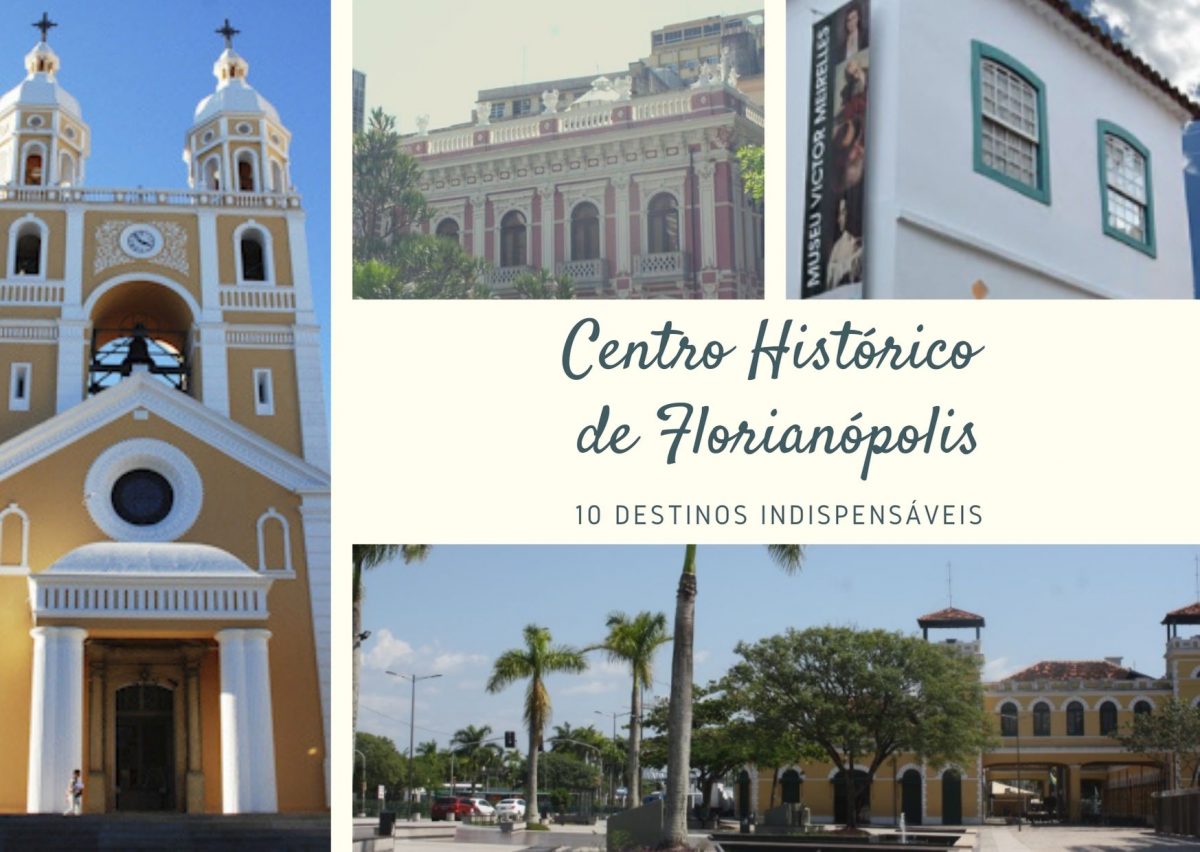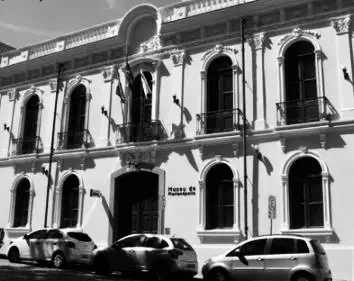Leisure for all tastes, typical gastronomy and cultural experiences are part of the itinerary of essential destinations in the Historic Center of the capital

Historical-cultural center of the capital of Santa Catarina, it was in the mediations of the Historic Center of Florianópolis where the city was originally founded and populated - initially named as Vila de Nossa Senhora do Desterro. However, today the place is still of extreme importance in the daily life of the island, concentrating attractions for the most varied audiences - between museums, historical monuments, living spaces and the harmonization of colonial classic architecture with contemporary buildings.
One of the factors that mark the Historic Center of Florianópolis is that the region has become a democratic space, where there is intense movement and circulation of people from all social classes and origins, from residents to tourists.
There are 10 essential destinations in the Historic Center region:
XV de Novembro Square
Built between 1885 and 1887, the XV de Novembro Square It has a name that honors the proclamation of the republic. However, it was once called Largo da Matriz and Largo do Palácio, as it is located close to both the Metropolitan Cathedral and the Government Palace.
It is pointed out that it was from Praça XV, as it is popularly known, that the colonization of the island started. It is not by chance that the site currently concentrates works that make the historical records of the capital vivid: the Monument in Honor of the Heroes Dead in the Paraguayan War and the busts that honor the poet Cruz e Sousa, the visual artist Víctor Meirelles, the historian José Boiteux and Jerônimo Coelho, who was the founder of the press in Santa Catarina.
The eye-catching Jardim Oliveira Bello is also one of the square's attractions. There are planted Indian ficuses, carnations, imperial palms, in addition to the Centenary Figueira, which is considered a Florianopolitan historical heritage. In addition, the footwear made in petit pavé, which refers to island folklore, was a work of artist Hassis and is one of the charms of the place.
Colonial Houses
Among the various colonial buildings that still leave vivid traces of Florianopolis history, there is a special emphasis on the set of five townhouses aligned and glued, on the east side of Praça XV de Novembro. The townhouses, which are now restored and occupied by commercial activities, were once home to manezinhos in colonial Brazil.
Santa Catarina Historical Museum
The Santa Catarina Historical Museum was founded in 1979, headquartered in the Customs Building. However, in 1986 it was transferred to Palácio Cruz e Sousa, where it still remains.
With work sanctioned by the then governor Brigadeiro José da Silva Paes, Palácio Cruz e Souza was originally going to be the Palace of the State Government. With colonial architecture and exuberance, the construction date is unknown - but there are records of the building in the year 1785.
The palace was the scene of several solemnities and political and military events - among them, visits by the emperors Dom Pedro I and Dom Pedro II.
After a structural expansion carried out in 1977, touches of neoclassicism were added to the palace. The building only received its current name in 1979, as a tribute to the symbolist poet Cruz e Souza.
Among the items in the museum's collection are the furniture by D. João V, the copy of the table of “The First Mass in Brazil”, by Victor Meirelles; violin, piano and a german style music box art nouveau, in addition to the first residential electric light bulb in Santa Catarina. In the garden, there is a memorial to the poet Cruz e Souza. In addition, periodic exhibitions appear on site.
Click here and check visiting hours and prices.
Metropolitan Cathedral of Florianópolis
With construction started in 1753 by Brigadier José da Silva Paes, the current Metropolitan Cathedral of Florianópolis practically saw the state capital grow. The current structure was erected on the exact same spot as the small church of Nossa Senhora do Desterro, originally built in 1675.
The building, which is listed by the Instituto do Patrimônio Histórico e Artístico Nacional, is also remembered for its exquisite collection of sacred art. Among her works stands out the wooden sculpture, carved by hand "Escape to Egypt", a masterpiece by the Tyrolean artist Demetz Groeden, which represents the escape of the Sagrada Familia - in life size. The stained glass mosaics present are also eye-catching, which bring external light into the interior of the church.
Also noteworthy are the German pipe organ, from 1924, the main carillon with five bells, from 1922, and the stained glass windows made in São Paulo in 1949.
The Metropolitan Cathedral has a website, which presents the history of the place, as well as information about the events of the current programming.
Victor Meirelles Museum
The Victor Meirelles Museum is dedicated to rescuing the memory and exhibiting part of the collection of the painter, draughtsman and professor, Victor Meirelles de Lima (1832-1903), remembered as one of the most important artists of the Romanticism in Brazil.
Born in Nossa Senhora do Desterro, currently Florianópolis, Victor Meirelles was the author of historical paintings, portraits, panoramas and one of the most famous of Brazilian canvases: “The First Mass in Brazil”, initially exhibited at the Paris Salon in 1861 and which today belongs to the collection of the National Museum of Fine Arts/IBRAM/MinC).
The Victor Meirelles Museum is located at Rua Victor Meirelles, number 59. opening hours can be consulted this link.
Museum of the Santa Catarina School
In the construction dating from 1892 where the Escola Normal Catarinense was housed, today is located the Museum of the Santa Catarina School (MESC-UDESC).
Historic heritage, the building is on top of a small hill and is marked by the neoclassical style.
Created in 1992, the MY C It was definitively installed in the building in 2007, with the site being used only for this purpose.
Currently, the space is managed by Santa Catarina State University (UDESC).
With structural improvements carried out in 2013, the museum has a large internal area of two floors, in addition to a basement. Such spaces house temporary exhibitions of visual arts, in addition to holding a series of periodical cultural events. In addition, there are the permanent exhibitions: the reproduction of classrooms from the period between 1932 and 1954, the collection "toys from my childhood" by Aldo Nunes, the furniture belonging to Professor Antonieta de Barros and wooden panels belonging to the old Academia de Comércio. There is also a cafeteria attached to the building.
Customs Square
One of the most popular circulation points in downtown Florianópolis, the Customs Square It has great historical importance for the city. Built in 1875, covering the Customs, the neoclassical-style building was fundamental for commercial activities on the island and remained in operation until the mid-1960s.
On February 08, 2020, Largo da Alfândega was reopened. The space, which is next to the Florianopolis Public Market, is a meeting and leisure point for locals and tourists. The recent renovation revitalized about 13.865 square meters and gave the place a look that makes cultural references to the island's customs, as well as bringing a modern and charming ambiance.
Now Largo has decks, paving, accessibility and landscaping, in addition to water features, which demarcate how far the sea went in the area - before the landfill. There are also rest areas, a flower shop, restrooms, tourist information centre, police station, handicraft sales and snack bars. The large metallic cover reproduces the shape of bobbin lace, a tradition inherited from Azorean immigrants.
Florianopolis Public Market
Built in 1896, replacing the old market that existed in Largo da Matriz, the Florianópolis Public Market is one of the main meeting points for residents and tourists who pass through the Center.
The place is considered one of the most socially democratic spaces in the city, as artists, bohemians, politicians, businessmen and common people circulate there, without any distinctions.
In addition to being an important point of varied commerce, the Public Market is a reference in typical island cuisine with Azorean influence. Some of the highlights served by the various bars and restaurants are: cockle and shrimp pastries, portions of seafood, fish broth mush, codfish balls, among others, which always go well with cold draft beer or sugarcane juice.
The Public Market restaurants are located in the central area, where folkloric and artistic presentations from the region are also held, with performances by the papaya ox or samba and pagode circles.
The history of the place is remarkable: the structure was already shaken by fires - in 1998 and 2005. In addition, in 2016 a very pleasant novelty was inaugurated: the central span received a cover composed of an automated metallic structure, covered with a resistant membrane, covered by a mass of polymers with PVC and protected by acrylic varnish on both sides.
Hercílio Luz Bridge
Known as the “Old Lady”, the Hercílio Luz Bridge It is the oldest of the three that connect the island of Santa Catarina with the mainland region of the capital. Inaugurated in 1926, the Florianopolitan postcard is consecrated to this day as the largest suspension bridge in Brazil. Its total length is about 819,471 m, with 259 m of insular viaduct, 339,471 m of central span and 221 m of continental viaduct. Its two towers measure approximately 75 meters from sea level, and the central span is 43 meters high.
The original project was authored by American engineers Robinson and Steinmann and all the material used in the construction was brought from the United States.
After remaining closed due to security measures since 1982, the Hercílio Luz Bridge was renovated and reopened on December 30, 2019. As a result, in addition to being exuberant and beautiful, the structure was once again used as an urban mobility option. In addition, in the surroundings of Velha Senhora there are two important points: a museum that tells the entire history of the bridge and the popular Parque da Luz.
In addition to the options mentioned, there are other points worth highlighting in the immediate vicinity of the Historic Center of Florianópolis, such as the Florianopolis Museum, which is located in the building where aa House of Chamber and Jail; to BADESC Cultural Foundation, located in the yellow house where he once lived Nereu Ramos and of course the very popular Rosary Staircase.
Author of the article: William Schütz
Contact by email: redacao.willianschutz@gmail.com
Image credit: Publicity/Guia Floripa.




